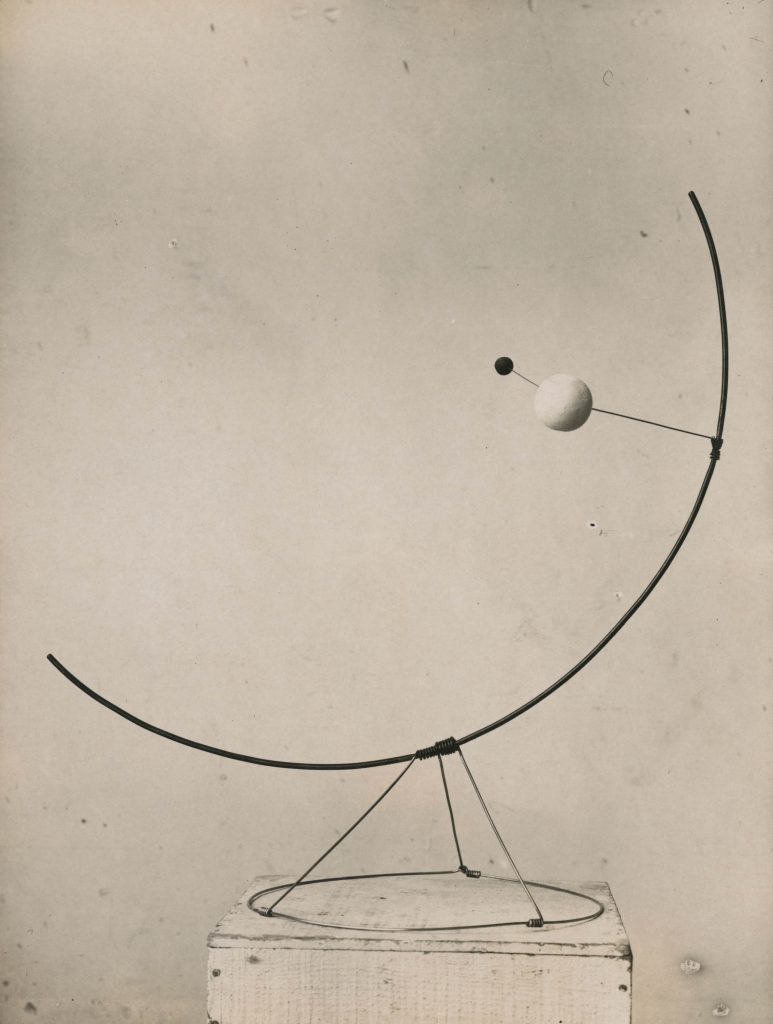
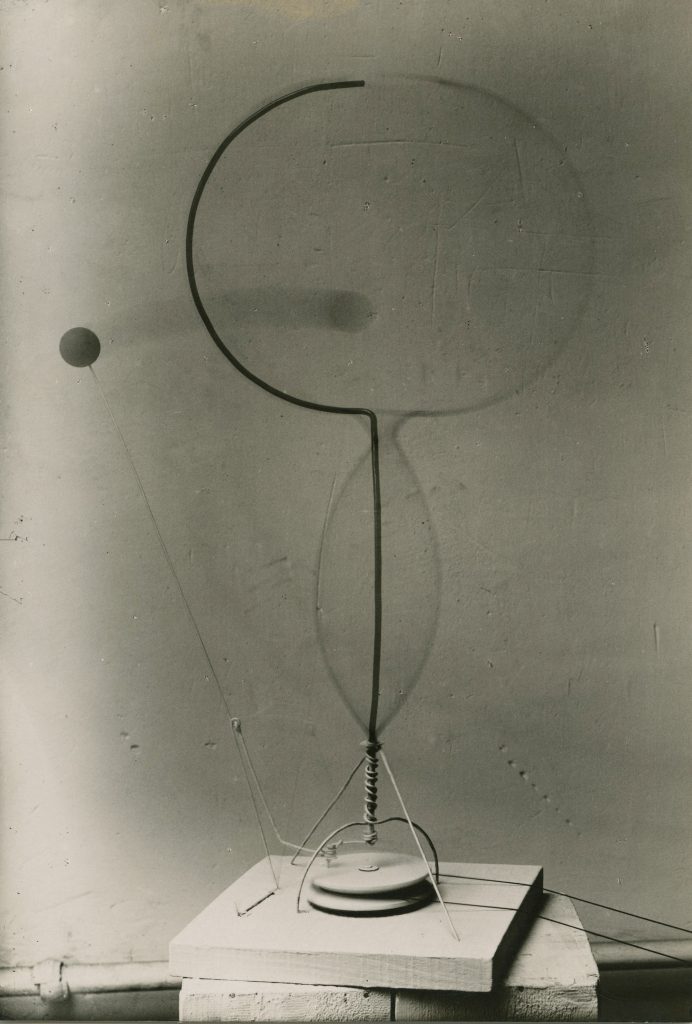
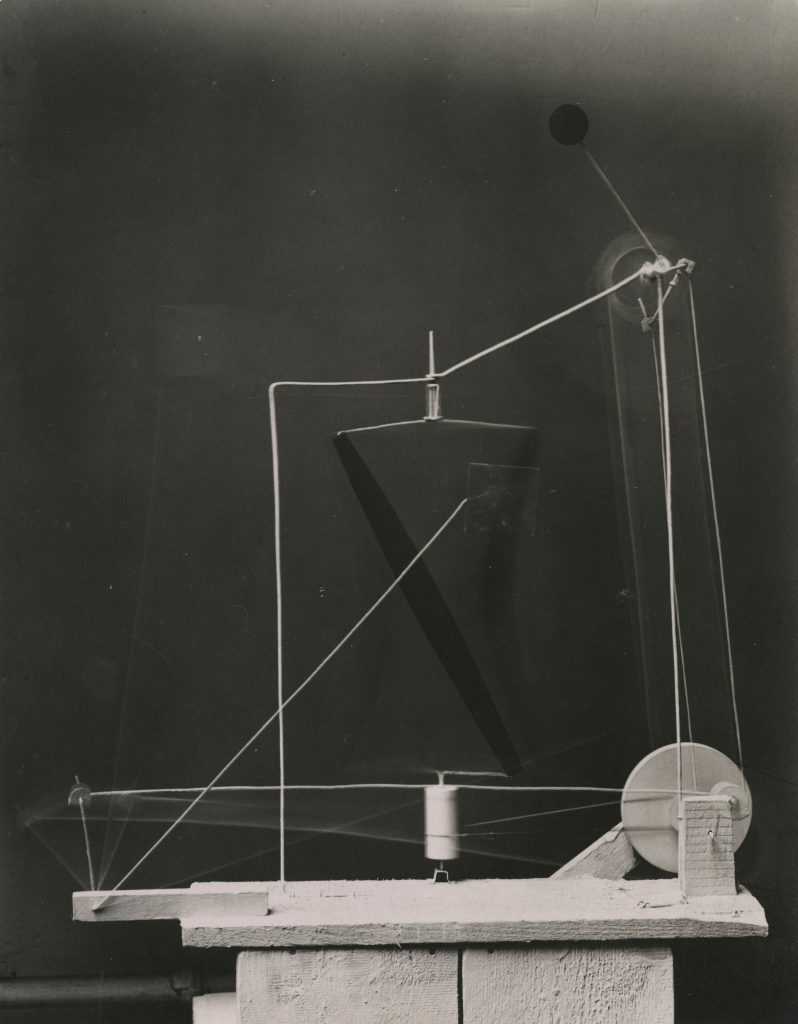
In August 1933, just one month after moving back to New York from Paris, Calder lent five sculptures to a group show at the Berkshire Museum in Pittsfield, Massachusetts. “The two motor driven ‘mobiles’ which I am exhibiting are from among the more successful of my earliest attempts at plastic objects in motion,” he wrote of Double Arc and Sphere and Dancing Torpedo Shape (both 1932). “The orbits are all circular arcs or circles. The supports have been painted to disappear against a white background to leave nothing but the moving elements, their forms and colors, and their orbits, speeds and accelerations.”[1] Incredibly, the Berkshire bought these two mobiles, marking Calder’s first sale to a museum. When Double Arc and Sphere and Dancing Torpedo Shape were surprisingly deaccessioned in 2018, the Calder Foundation seized the opportunity to acquire them, as they were unlike anything else in our collection. Now, after a year of conservation, we can once again engage with these early masterpieces as my grandfather meant them to be experienced. We are confronted with an extraordinarily complex and sensitive series of movements.
–
Having the chance to closely examine the earliest stages in the evolution of the mobile allows us to bring into focus heretofore hidden or misunderstood aspects of this revolutionary activation of sculpture. It can be difficult to grasp Calder’s epochal transformations, even with hindsight. One convincing origin story begins with his dynamic brush drawings of animals in action. My grandfather made hundreds of these live sketches during trips to the Bronx and Central Park zoos in the winter of 1925, while still enrolled at The Art Students League in New York. The following year, 141 of them were published in his manual Animal Sketching.
Animals—Action. These two words go hand in hand in art. Our interest in animals is connected with their habits, their food, the animals they prey upon or that prey on them, their habitats and protective coloring. Their lives are of necessity active and their activities are reflected in an alert grace of line even when they are in repose or asleep … There is always a feeling of perpetual motion about animals and to draw them successfully this must be borne in mind.[2]
The sense of the animals springing to life is conveyed through the striking fluidity of my grandfather’s brushwork. In capturing their nuances, he brilliantly transmits the uniqueness of each animal.



Within a year, Calder had transformed the potential energy of these bold lines into three-dimensional sculptures drawn in space with wire. Here he defined spatial contour and volume, but omitted solidity and mass. This disruption of established norms unsettled both artists and critics, who were hard-pressed to define Calder’s radical new works. Sculpture had always been either carved or modeled in solid material. If they were not sculpture, what were they? They obviously weren’t drawing or painting either—or music, dance, or theater—but they were somehow an amalgam of all of these things. The wire that shaped these figurative works could shiver and tremble, thereby injecting the actual movement of a living form into the art of sculpture. Some of Calder’s portraits, which rotate and vibrate when suspended from the ceiling—they include Jimmy Durante (c. 1928) and John Graham (c. 1931)—could be considered proto-mobiles. The projected shadows of these massless portraits move in and out of focus on the flat wall, creating a cinematic and multidimensional experience. When Calder made Goldfish Bowl (1929) as a Christmas gift for his mother, Nanette, he devised a crank-driven mechanism to activate the two fish, which “swim” in a thrillingly supple fashion. The articulation in this work is the precursor to some of the animated abstractions that developed over the next two years.
More and more, Calder was focusing on actions rather than images. Specific details were jettisoned. Gesture moved to the forefront. My grandfather wrote of his wire works in 1929: “They are still simple, more simple than before; and therein lie the great possibilities which I have only recently come to feel for the wire medium.”[3] Among the works he presented with the Surindépendants in 1930 were two gestural figures: a tumbler midstride, unwinding into her acrobatics, and a shot-putter at his full extension. Both are perched on a single foot in mid-action. In Circus Scene (1929), he pushed beyond figuration to express the forces at work: a quivering acrobat, caught mid-air in a hand-to-hand act by his bigger brother, is reduced to two arcing wires, defining the vector of his flight. The thick and thin gauges of wire in the figures emphasize the dynamics at work rather than illustrating a literal description. This is one of the key sculptures in Calder’s transition from gesture to abstraction. His use of contrasting gauges of wires expressing amplitudes of energy is a technique he soon incorporated in works such as Croisière (1931).
In October 1930, my grandfather visited Piet Mondrian’s studio, where the totality of the environment-as-installation shocked him.
It was hard to see the ‘art’ because everything partook of the art … It was all one big decor, and the things in the foreground were lost against the things behind. But behind all was the wall running from one window to the other and at a certain spot Mondrian had tacked on it rectangles of the primary colors, and black, gray, + white. In fact there were several whites, some shiny some matte. This caught my attention, and somehow I thought it would be nice if these rectangles oscillated—not much, but a little. I said so to Mondrian—and he said, ‘Oh no, it’s very fast as it is.’ Later, when I had made some ‘mobiles’ he still maintained that he held the speed record. But I was much impressed by the simplicity and exactitude, and I went home and for 1 ½ weeks I tried to paint.[4]
Mondrian didn’t necessarily intend his environmental installation as a work of art; for him this was the space in which he made his paintings and contemplated the possibilities of what he called “pure plastic art.” As for Calder, although he clearly responded to Mondrian’s paintings, it was his reaction to the experience of Mondrian’s studio that pushed him to embrace a completely abstract language of form. His first nonobjective works, which were oil paintings, are distillations not only of Calder’s European influences—scholars often reference works by Mondrian, Malevich, and Kandinsky—but also of the work of a number of American abstractionists, especially Arthur Dove.
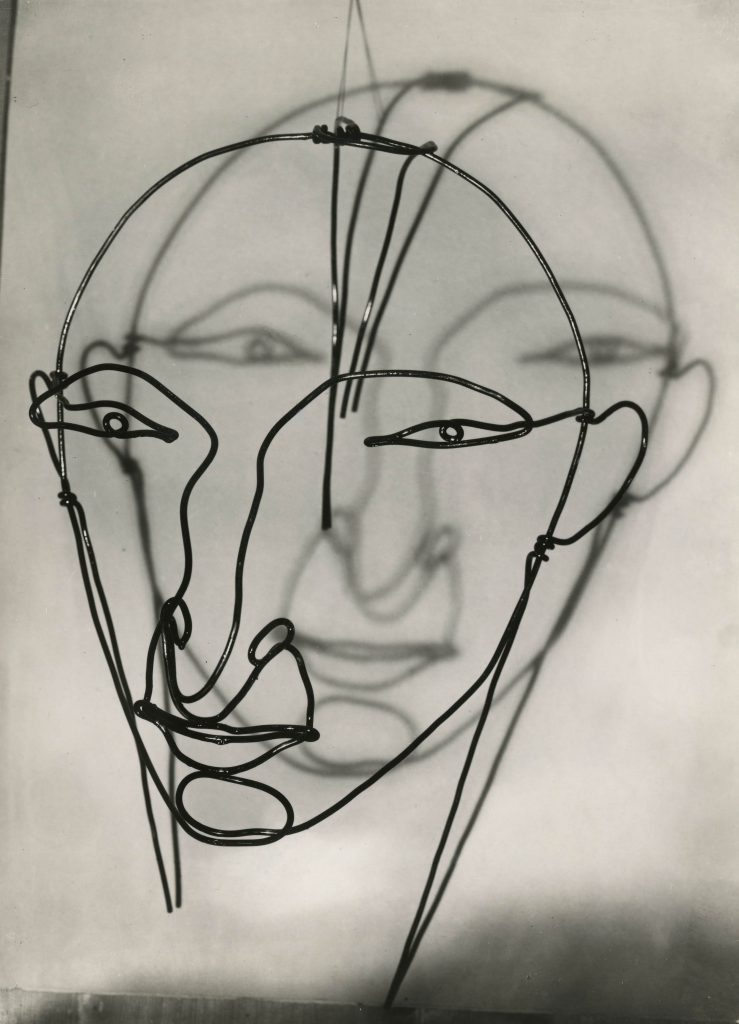
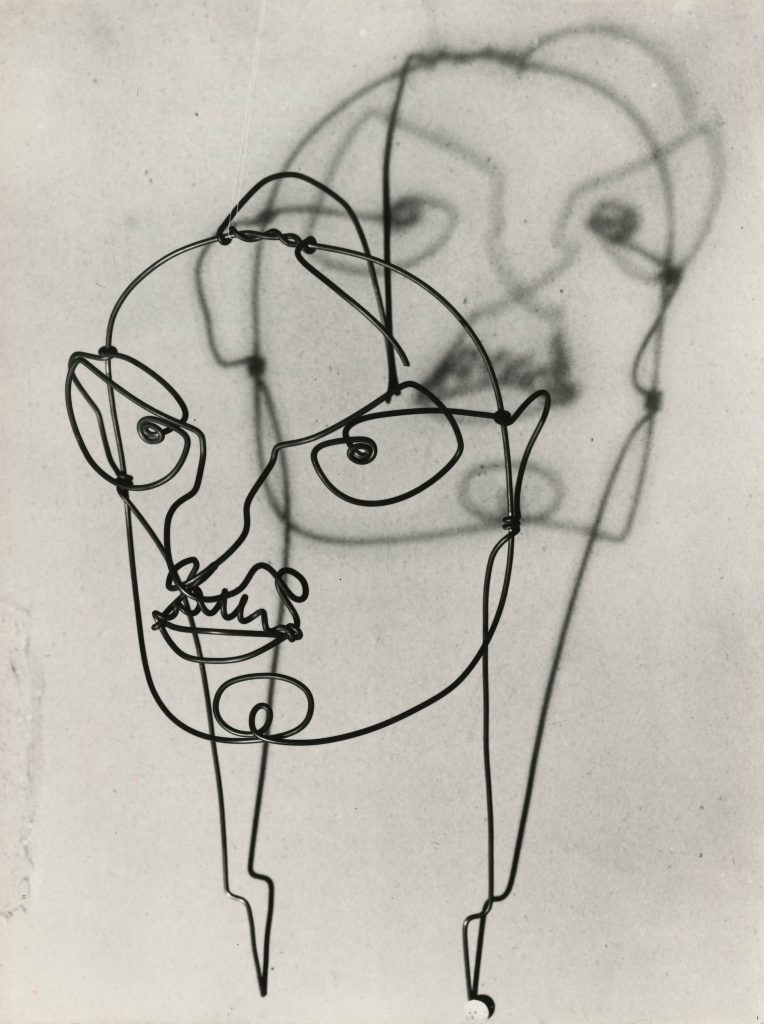
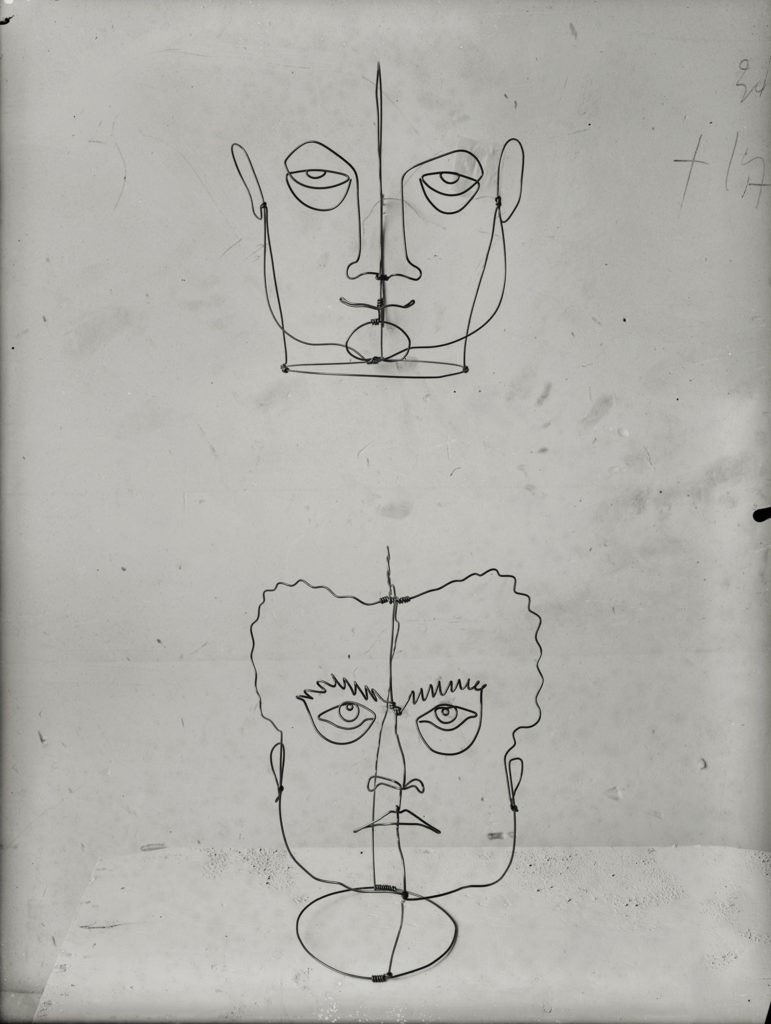
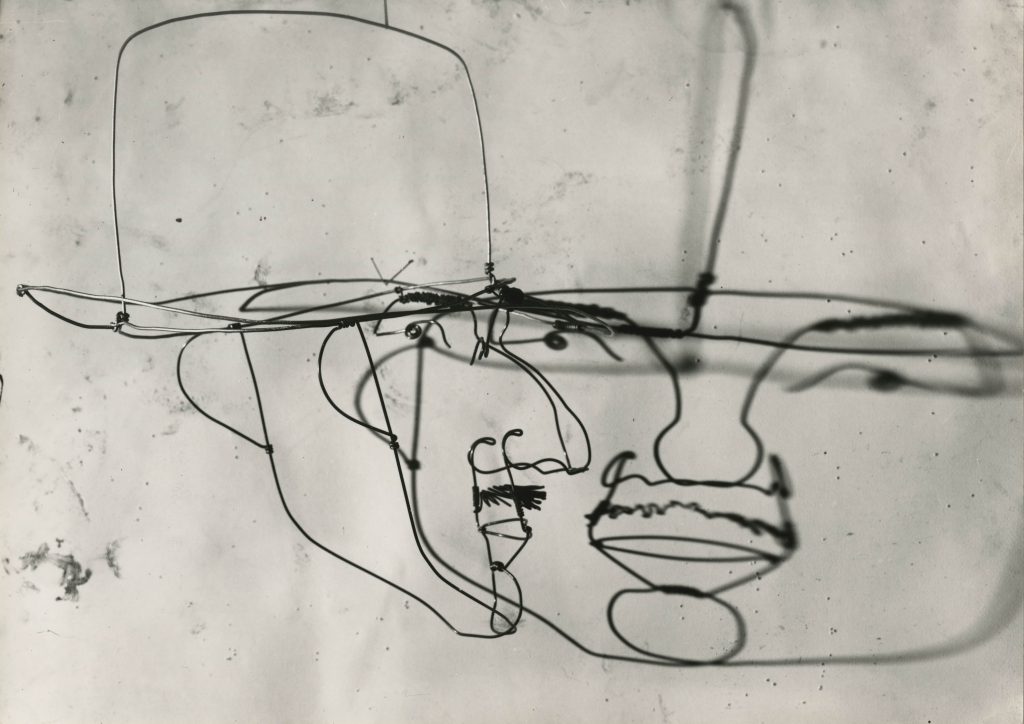
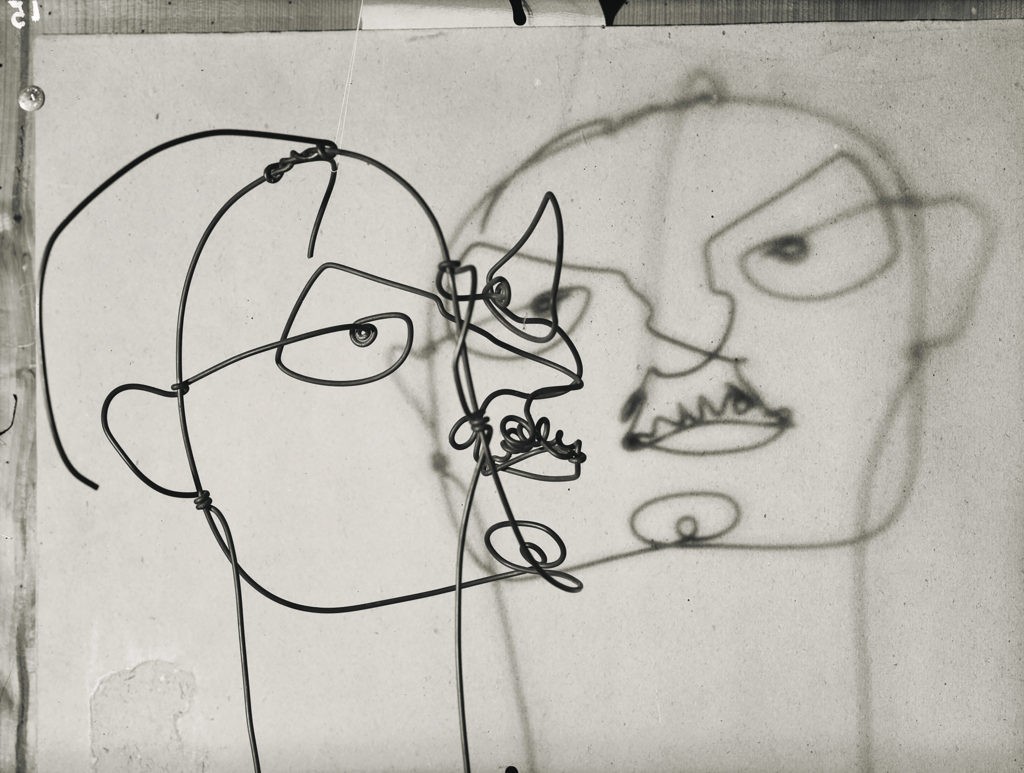
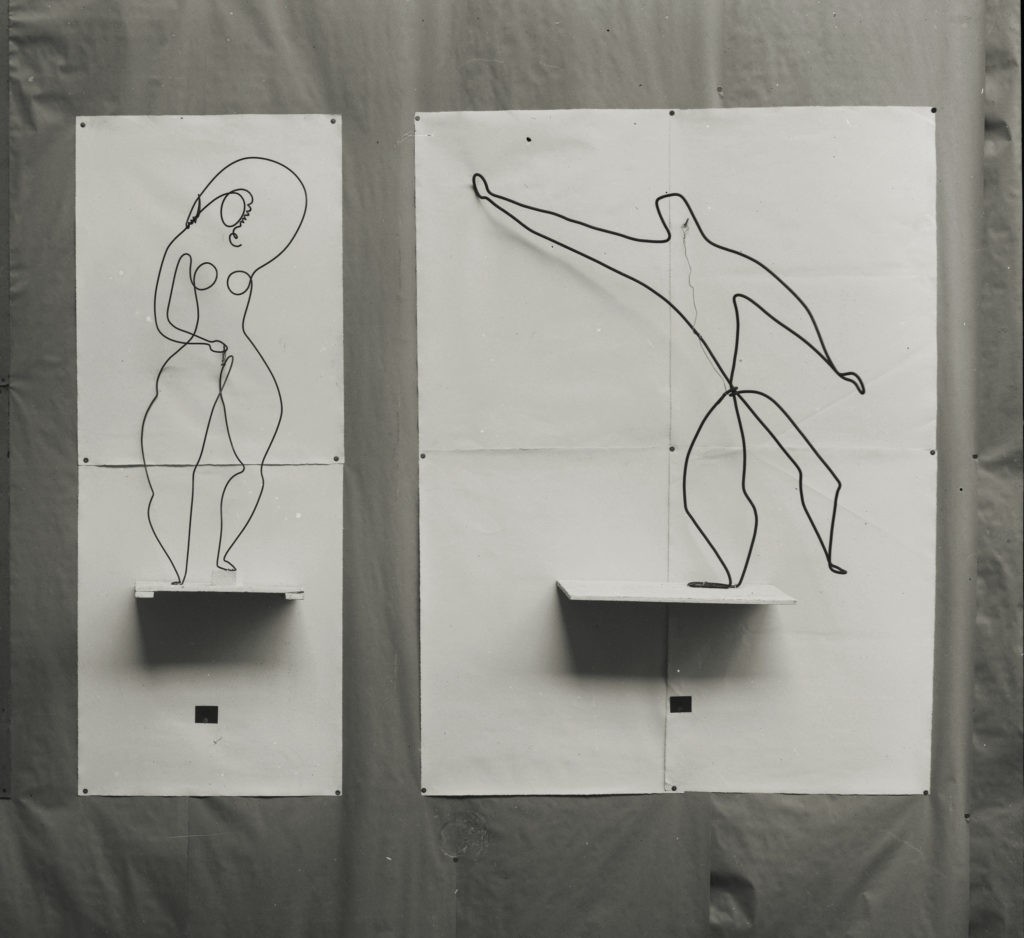
Two Spheres Within a Sphere (1931) zeroes in on the interdependency of three spatial forms. By means of a hand-driven crank, much like the one in Goldfish Bowl, two small orbs—one red, one black—circulate within a void-space defined by two intersecting wire circles.
When I use two circles of wire intersecting at right angles, this to me is a sphere—and when I use two or more sheets of metal cut into shapes and mounted at angles to each other, I feel that there is a solid form, perhaps concave, perhaps convex, filling in the dihedral angles between them. I do not have a definite idea of what this would be like, I merely sense it and occupy myself with the shapes one actually sees.[5]
Calder’s art defines a place that exists parallel to nature. The building blocks of the natural world—pure geometry and freewheeling energetic forces—are what interested him. He had little concern for the things we know—a human body or a landscape, for example—and twisting them into images that express emotions. His sculptures cut sensual lines through our environment with ephemeral motions. They actualize the potential of energy.
The most refined work of 1931, Object with Red Ball, is a profound meditation on the nature of the sphere. The elements are simple: a solid red sphere made of wood, an implied black sphere made of two intersecting sheet metal discs, and a large hoop representing a three-dimensional spherical void-space, but defined within two dimensions. As the white structure melds with the wall behind, the three spheres are left suspended in an otherworldly realm. “There is the idea of an object floating—not supported—the use of a very long thread, or a long arm in cantilever as a means of support seems to best approximate this freedom from the earth.”[6] But what is most remarkable about this work remains unseen. Intervention by the viewer is essential: the red and black spheres hang along a horizontal rod and are unfixed and repositionable, while the vertical white post, held upright by a thick internal pin, can be rotated anywhere within 360 degrees. Calder intentionally left the final orientation open for the viewer to complete, without the suggestion of any definitive or perfect composition. This was a radical idea—one he proceeded to explore more fully the following year.
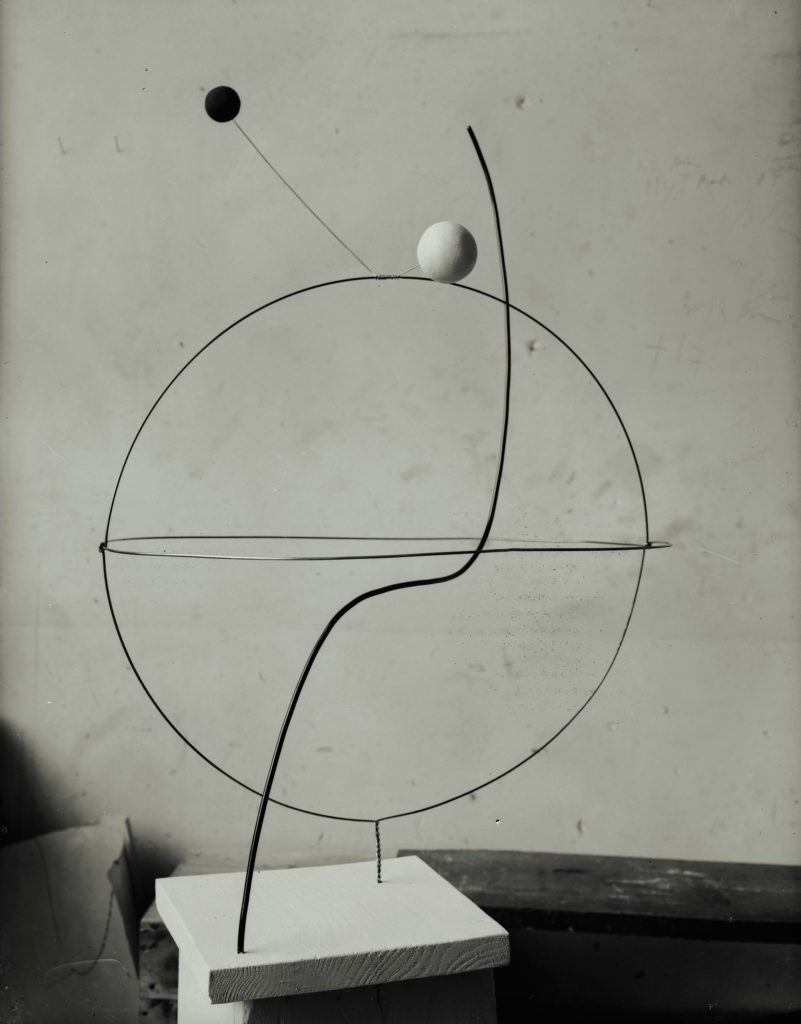
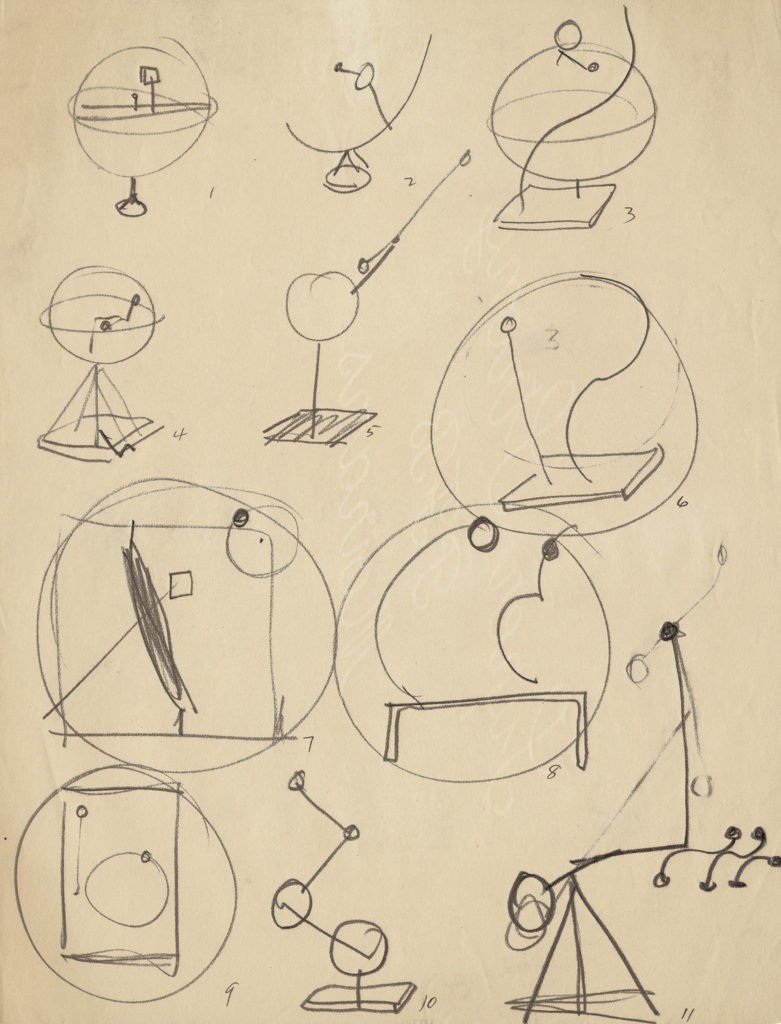
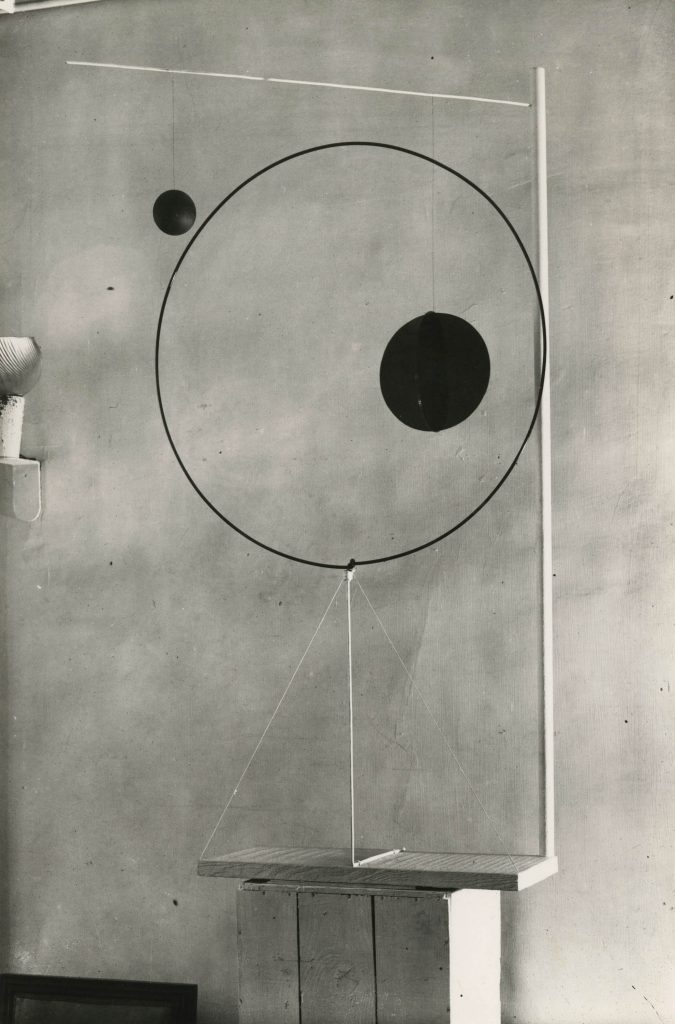
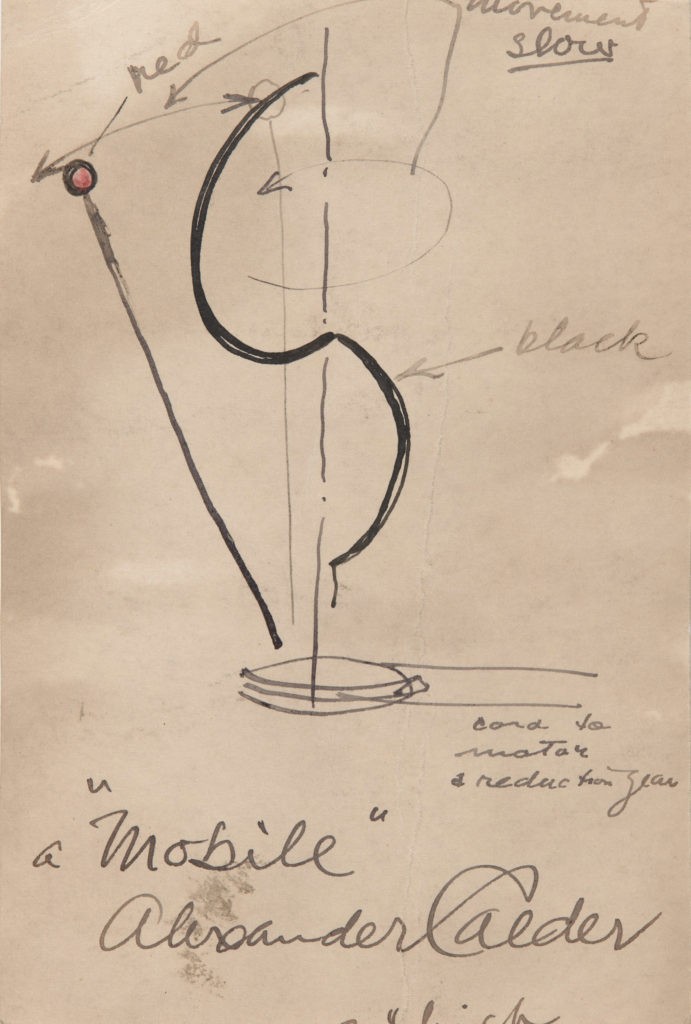
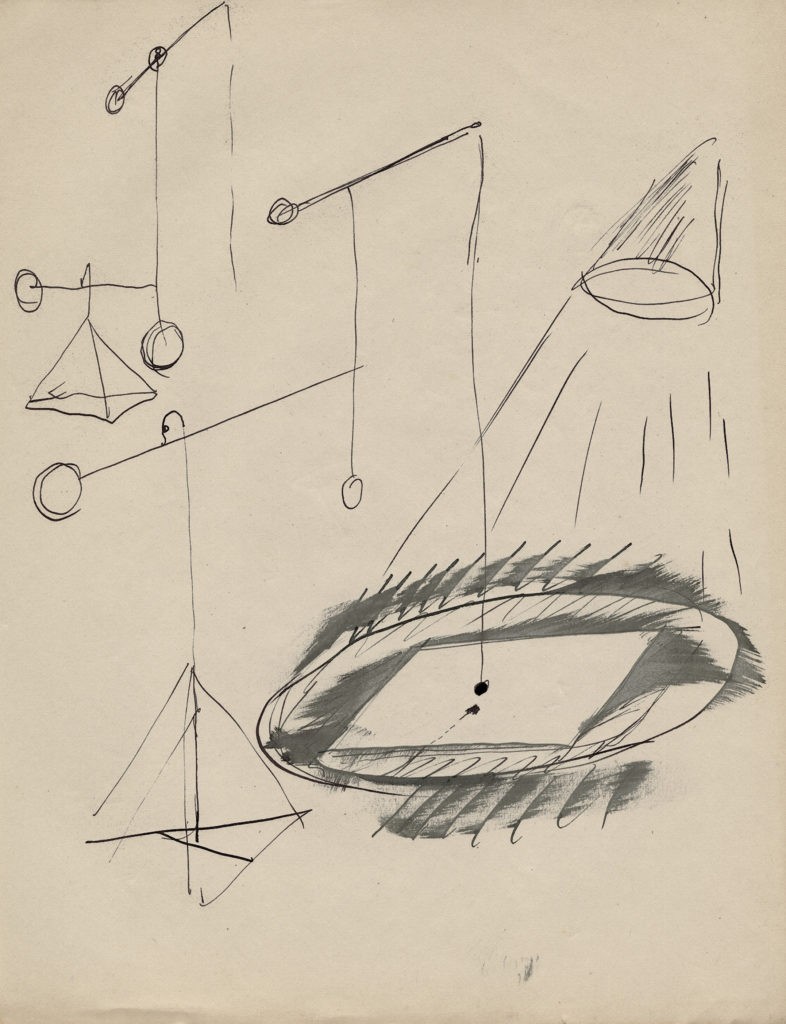
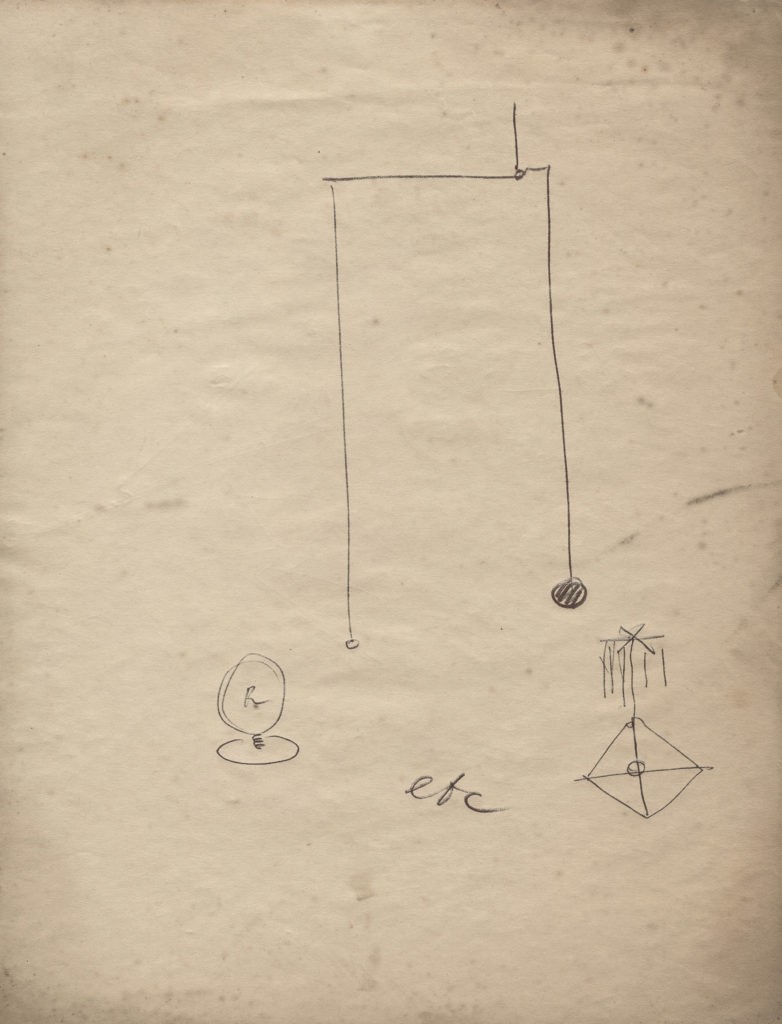
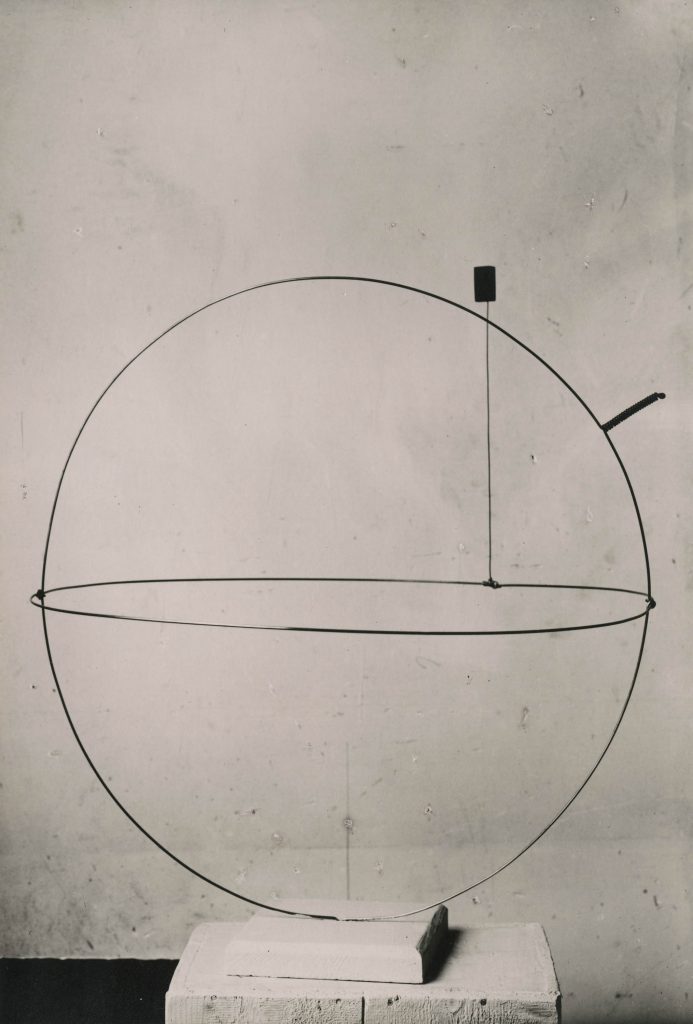
My grandfather’s kinetic evolution became even more audacious with the two motorized works that he presented at the Berkshire Museum in 1933. “The esthetic value of these objects cannot be arrived at by reasoning,” he explained. “Familiarization is necessary.”[7] There is a powerful geometric imagination at work in these objects. In Double Arc and Sphere, a sculpture clearly related to Object with Red Ball, the top segment is a half circle and the bottom segment is a quarter circle. Since the bottom arc is the same height as the top arc, we immediately sense a mathematical interdependency in their spherical volumes. And that relationship is further complicated by the red sphere, which “nods in” and violates the tranquil space. Dancing Torpedo Shape has a shiny square that floats as its armature arcs, maintaining a constant relationship with Earth’s gravitational field. The sphere has its own dependable movement, while the torpedo shape has a rhythmic action.
Both Double Arc and Sphere and Dancing Torpedo Shape have a metaphysical power that transcends their mechanical operations. What counts are the interrelationships between the objects in motion. “I went to the use of motion for its contrapuntal value,” Calder wrote, “as in good choreography.”[8] Complete and complex performances of three simple elements, these works float free of their “canvas.” In a drawing made of Double Arc and Sphere, Calder specified “movement slow,” and it is surprising to learn that some of these early motor-driven works move so slowly that their kinetics can only be discerned by looking away and back again. They were not intended to whiz around. The dynamics are imaginative provocations rather than mere entertainments. It was in fact a motor-driven object, sister to these Berkshire sculptures, that first prompted Marcel Duchamp to propose the term “mobile” during a visit to Calder’s studio in fall 1931. “There was one motor-driven thing, with three elements. The thing had just been painted and was not quite dry yet. Marcel said: ‘Do you mind?’ When he put his hands on it, the object seemed to please him.”[9]
The early development of the mobile reached a climax with the percussive Small Sphere and Heavy Sphere (1932/33). This was the very first mobile that Calder suspended from the ceiling, reaching for a new synthesis of visual, kinetic, and aural experience. He was engaging the audience in an activation of the object that promised to give avant-garde sculpture a musical dimension. There are two preparatory drawings for it: the first grafts a standing mobile that operates a small sphere to a theatrical proscenium; the second develops the idea further, supplanting the elaborate derrick with a suspended horizontal rod to control the sphere as it advanced toward the sounding objects. Calder ultimately simplified these objects or the “impedimenta” as he called them by repurposing seven items (a wooden crate, a tin can, and five glass bottles of various types) plus a gong that he made. Today, we fetishize these objects, but they could actually be replaced with any number of contemporary elements in an extraordinary conceptual ensemble. The heavy cast-iron sphere, acting as a reservoir of potential energy, is also a found object, a four-pound counterweight from some unknown device; the small sphere is made of wood. The arrangement of the objects is not fixed. Calder wanted viewers to intervene and freely organize the impedimenta themselves, thereby removing the artist’s control of the final composition.
When the heavy red sphere is pushed, the small white sphere is thrust into a series of engagements and near misses with the impedimenta. The movements of the small sphere precipitate unpredictable impressions, often provoking unsettling emotions. Viewers can’t help but try to anticipate a pattern where in fact none exists. The result is a tantalizing performance with periods of expectation and tension followed by moments of surprise and emotional release. Calder intended Small Sphere and Heavy Sphere to exist as an idea—one that can be freshly realized over and over again—with the idea being the only fixed aspect of the composition. As for the aural experience, the music is instigated by the viewer’s direct contributions. In fact, it’s the performance and only the performance that completes the work. With Small Sphere and Heavy Sphere, art becomes something to experience in a perpetual present—a present that is always unfolding. As with all of Calder’s work, the genius of Small Sphere and Heavy Sphere has everything to do with the intersection of the material and the immaterial.
Over time, Calder pushed the mobile in many different directions. Untitled (1934), a standing mobile of five carved elements of diverse species of wood, reflects the expansion of his aesthetic vocabulary after his return to the United States in 1933. With works such as Untitled (1937), my grandfather began to fully explore and make explicit the kinetic dimensions that had always been implicit in the art of painting. He had first thought about this when he was in Mondrian’s studio, and suggested that the rectangles of colored paper that the Dutch artist had experimented with might be made to oscillate. Such works, which today we tend to refer to as wall sculpture, were regarded simply as mobiles in the 1930s. In Calder’s exhibition at the Curt Valentin Gallery in 1955, three Red Maze mobiles hung at chest height and created a transitional space—as in the best architecture—so that as visitors moved through the gallery they were highly conscious of their physical proximity to the sculptures.[10] It was tight. The largest one, Red Maze III (1954), has a vibrant grace of symphonic absences. Black Mobile with Hole, also from 1954, reaffirms many of Calder’s advances of the previous decades, and contains a large void that is established by a wire. Finally, Black Gamma (1966) engages horizontals and verticals that evoke the Greek letter gamma, itself a unit of magnetic flux density equal to one nanotesla (which I won’t try to explain!).
–
The radicalism of Calder’s artistic escapades is difficult to fully appreciate today. How can we comprehend the nature of the mobile, which is a painting with an unfixed composition that has been released from the wall? His art depicts nonobjective kinetic flux and creates meaning through sensation. “This has no utility and no meaning. It is simply beautiful. It has a great emotional effect if you understand it. Of course if it meant anything it would be easier to understand, but it would not be worthwhile.”[11] My grandfather’s statement remains as challenging today as it was in 1932, when he set out to explain his work to a puzzled reporter. To experience intense emotion in a work of art that has no fixed meaning requires self-awareness, or maybe a maturity that only develops after many years. Calder wants us to connect with his heightened arena of kinetic experience. His work challenges us to approach art through intuition. His grand proposition is that we interact with his work. That interaction is the spark that sets off an emotional charge and leaves us with a lasting sensation of the universal connection.
Pace Gallery, New York. Calder: Small Sphere and Heavy Sphere. 14 September–26 October 2019.
Solo ExhibitionHauser & Wirth, Somerset, England. Calder: From the Stony River to the Sky. Exhibition catalogue. 2018.
Susan Braeuer Dam, For the Open Air
Jessica Holmes, More than Beautiful: Politics and Ritual in Calder’s Domestic Items
Solo Exhibition Catalogue“Calder in France.” Cahiers d’Art, no. 1 (2015). Edited by Alexander S. C. Rower.
Susan Braeuer Dam, Calder in France
Robert Melvin Rubin, An Architecture of Making: Saché and Roxbury
Agnès Varda in conversation with Joan Simon
Magazine, MonographAlmine Rech Gallery, New York. Calder and Picasso. Exhibition catalogue. 2016.
Robert Slifkin, The Mobile Line
Susan Braeuer Dam, Liberating Lines
Jordana Mendelson, Picasso, Miró, and Calder at the 1937 Spanish Pavilion in Paris
Group Exhibition Catalogue“Calder in France.” Cahiers d’Art, no. 1 (2015). Edited by Alexander S. C. Rower.
Susan Braeuer Dam, Calder in France
Robert Melvin Rubin, An Architecture of Making: Saché and Roxbury
Agnès Varda in conversation with Joan Simon
Magazine, Monograph